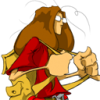Should the player be just another entity in the entities list?
perhaps with additional player specific data?
or should the player be a separate stand alone data structure with no entry in the entities list?
sometimes i see the player as simply another entity with extra data, that takes its input from the keyboard and mouse, instead of from AI.
i suppose the thing to do is make the player a separate data structure which shares common data structures with entities.
IE have a location struct: x,y,z.
and instead of entity and player x,y,z variables, you have entity.location and player.location.
and have methods that operate on a location struct, which therefore works for both player.locations and entity.locations.
that kind of idea....
how do you (or the game engine you use) do it?
I'm about to start serious coding on SIMSpace 8.0, and this is about the only thing i haven't decided on yet.
any recommendations?















